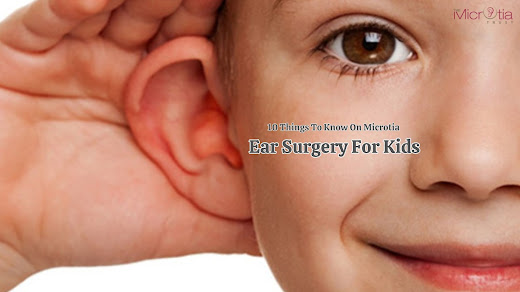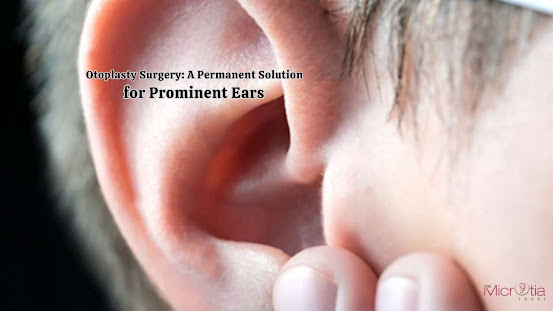10 Things To Know On Microtia Ear Surgery For Kids
Microtia term originates from two Latin words: “micro”, which means small, and “Rita”, which means ear. Microtia is a structural defect in the outer ear (pinna), present at birth. This congenital abnormality can range from minor structural issues in the outer ear to the complete absence of an external ear (anotia) which leads to hearing problems.
In this guide about Microtia Ear Surgeon in India, Dr. Parag Telang, we will discuss 10 important things to know about Microtia ear surgery for kids. This will help parents learn more about microtia and how it can be corrected.
1. Signs and Symptoms of Microtia Ear in Kids
Usually, microtia affects only a single ear but it can occur in both ears. This condition is characterized by the appearance of a small ear with an unusual shape. There are four grades of microtia, based on the severity of the condition. These are:
Type 1- The external ear (pinna) is smaller than normal ear size. All structures of the ear are present but are abnormally formed.
Type 2- The external ear is small and partially formed.
Type 3- There are some auricular structures present but no recognized ear parts.
Type 4- There is complete absence of an external ear. This condition is called anotia.
2. Causes of Microtia
Microtia ear usually develops during the first trimester of pregnancy, while the ear is still forming. Often, this happens when women have diabetes, consume alcohol, take certain medications, and have a diet low in carbohydrates and folic acid at the time of their pregnancies. However, it can even be a feature of a major syndrome such as hemifacial microsomia. Hemifacial syndrome is a medical condition that affects the face of the baby before birth. In some cases, microtia is hereditary.
3. Surgical fixing of microtia ear using rib cartilage- The Procedure
Microtia ear surgery involves reconstruction of the ear using rib cartilage. During the procedure, a plastic/reconstructive surgeon creates a new ear out of the cartilage taken from the ribs of the child. The rib cartilage reconstruction for microtia is performed in multiple stages, involving anywhere between 2-4 surgeries.
The procedure involves the following steps:
First, the patient is anesthetized, preferably with general anesthesia, to avoid any surgical discomfort.
The surgeon starts the surgery in a sterile environment by first cleaning the chest of the patient. An incision is made in the chest to remove cartilage (usually cadaveric cartilage) from several ribs.
Next, the surgeon meticulously carves and pieces together each of the cartilage to form an ear framework.
Then, the constructed ear framework is buried under the scalp precisely in its destined place in line with another ear. Once it’s done, the ear is left to heal.
After the reconstructed ear heals, the surgeon performs more surgeries to finish the ear reconstruction process. The other surgeries involve bringing ears away from the scalp, repositioning the ear lobe, and other adjustments.
4. Result of microtia ear surgery
The child’s reconstructed ear heals completely in up to three months. With a new ear of proper size and shape, the child feels more confident.
5. Preparation for microtia ear surgery
The surgeon will evaluate the child’s ear abnormality and find out the grade of microtia during the initial consultation. If the child holds a candidacy for microtia ear surgery using rib cartilage, the surgeon provides details of the surgery including the pre and post-treatment guidelines, risks, and benefits. The child will be notified about which medications/supplements to discontinue or avoid having beforehand. A 3D CT scan will be performed of the child’s microtia ear for future use in creating a customized reconstructed ear.
6. Aftercare Following microtia ear surgery
Following microtia ear surgery using rib cartilage, it is recommended to:
Take prescribed pain medications for pain relief.
Avoid sleeping on the side having a reconstructed ear.
Avoid placing pressure or rubbing the reconstructed ear.
Wear buttoned shirts or shirts with loose-fitting collars.
Avoid any strenuous physical activities or contact sports that could cause damage/trauma to the ear for 3-4 weeks.
Resume work or going to school within 2-3 days of the surgery.
Schedule follow-up visits to ensure proper recovery is taking place.
7. Ideal candidates for microtia ear surgery
Healthy children belonging to the age group 6-10 years
Fully grown children have sufficient cartilage in their ribs to carve an ear framework.
8. Benefits of microtia ear surgery
Micro ear surgery in India by Dr. Parag Telang using rib cartilage has the following advantages:
The surgical technique exclusively makes use of the body tissues of the patient. Therefore, there is no risk of tissue rejection.
It is a well-proven invasive procedure to reconstruct an ear affected by microtia. It is a standard surgical technique to correct microtia for more than 4 decades.
When performed by skilled hands of expert surgeons, the surgical outcome is excellent and long-lasting.
Following the surgery and healing, the reconstructed ear can withstand the rigors of most sports.
9. Risks associated with microtia ear surgery
The removal of rib cartilage may cause deformity of the chest wall of the child. It’s a painful procedure that may leave behind permanent scars.
There are chances of the appearance of a “hairy ear” as the cartilage framework is placed under the existing scalp with a low hairline.
There could be common surgical risks like bleeding, infection, and anaesthesia-related reactions.
10. Connect with a Microtia Surgeon in India for more details.
Dr. Parag Telang is a renowned expert in microtia ear correction and reconstruction. He has successfully assisted numerous children born with deformed ears, individuals involved in accidents, and burn victims who have lost their ears. Through his advanced ear reconstruction surgeries, he has provided many people with the opportunity to regain a healthy and natural-looking ear, ultimately restoring their confidence.
Contact him today at The Microtia Trust for more details.



Comments
Post a Comment